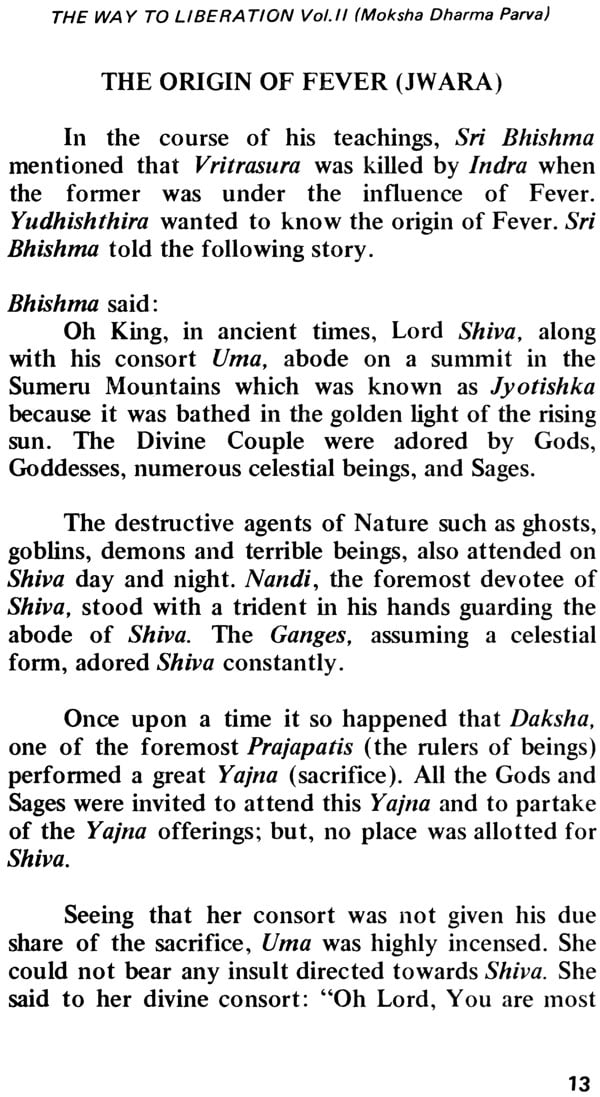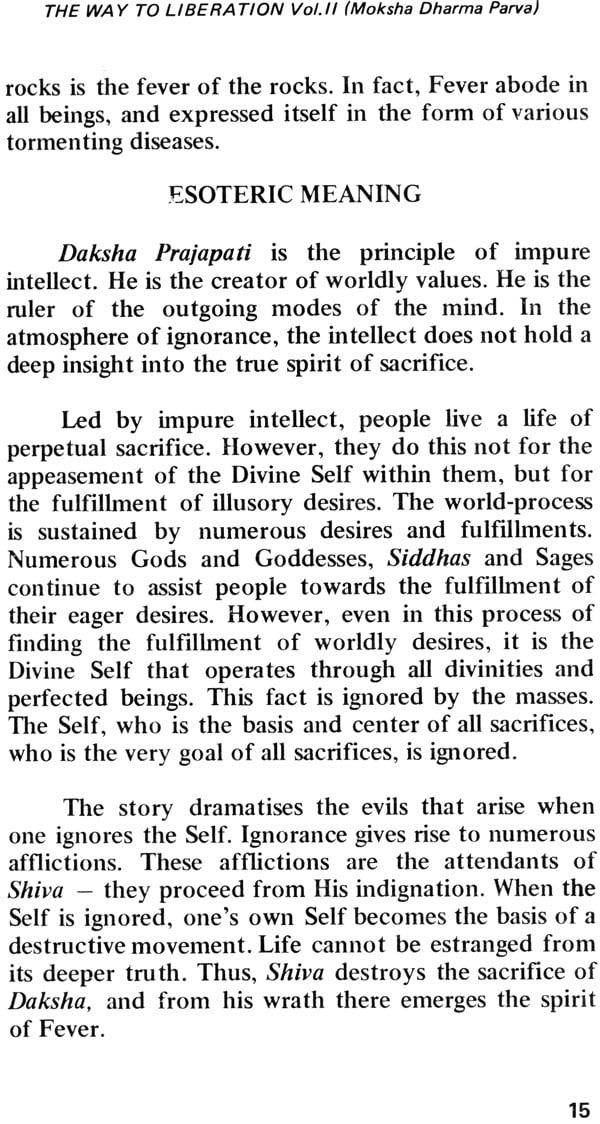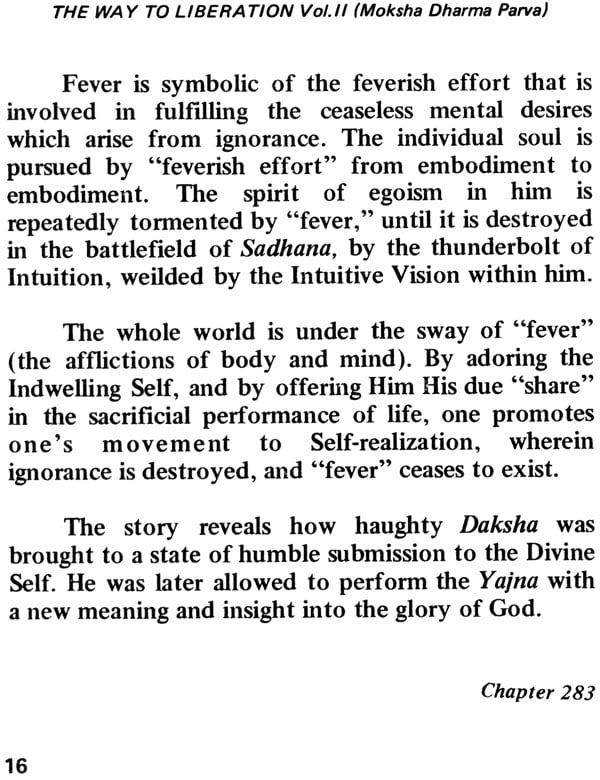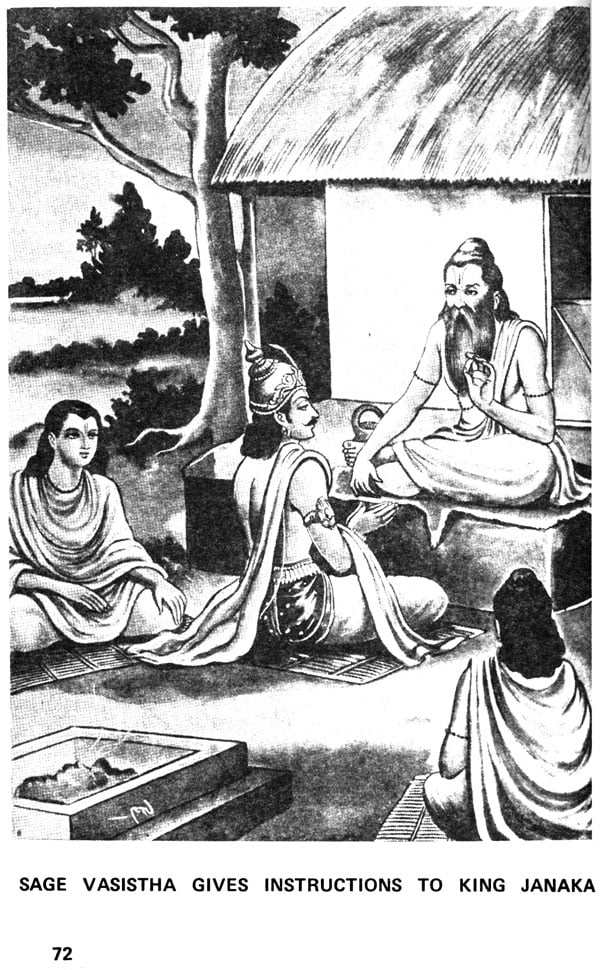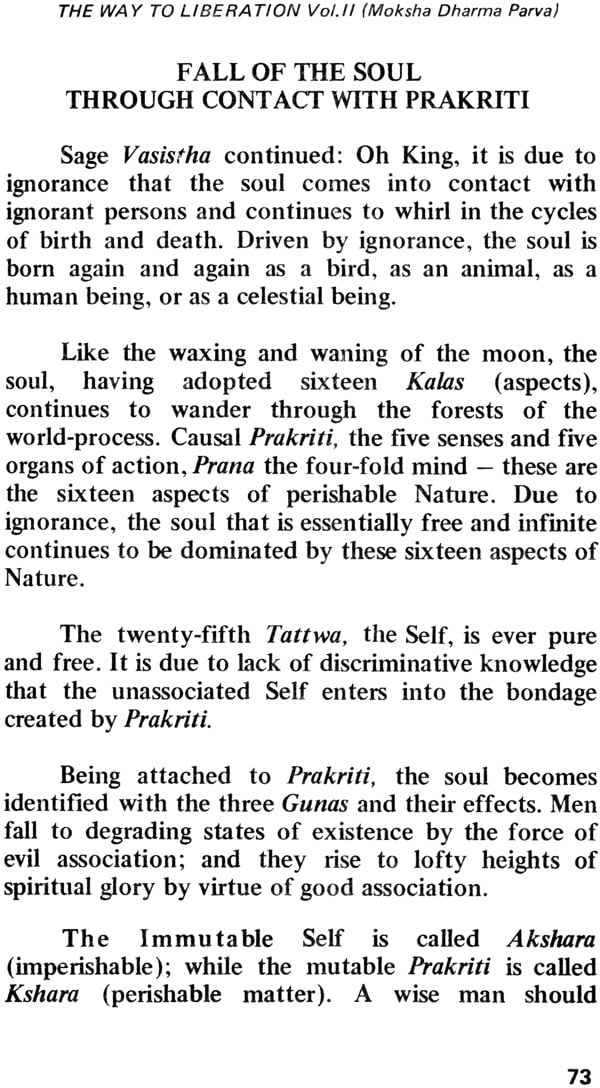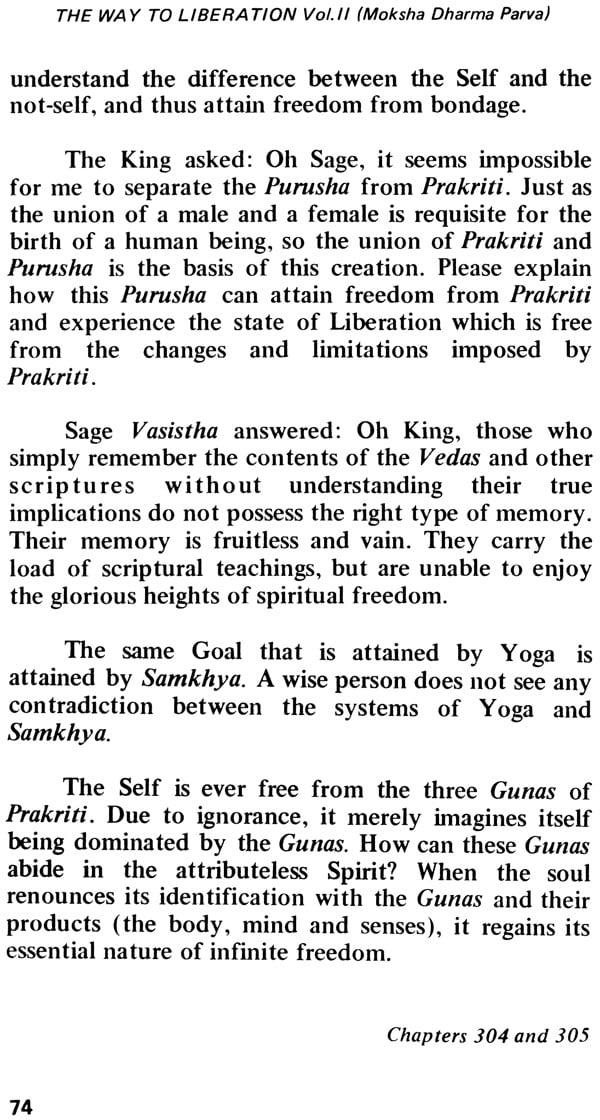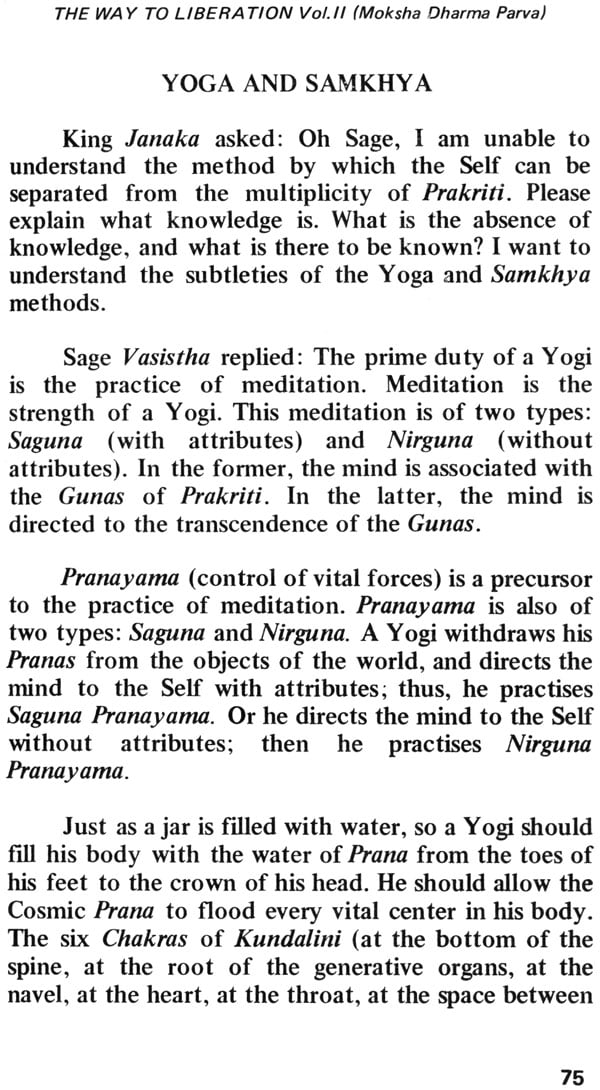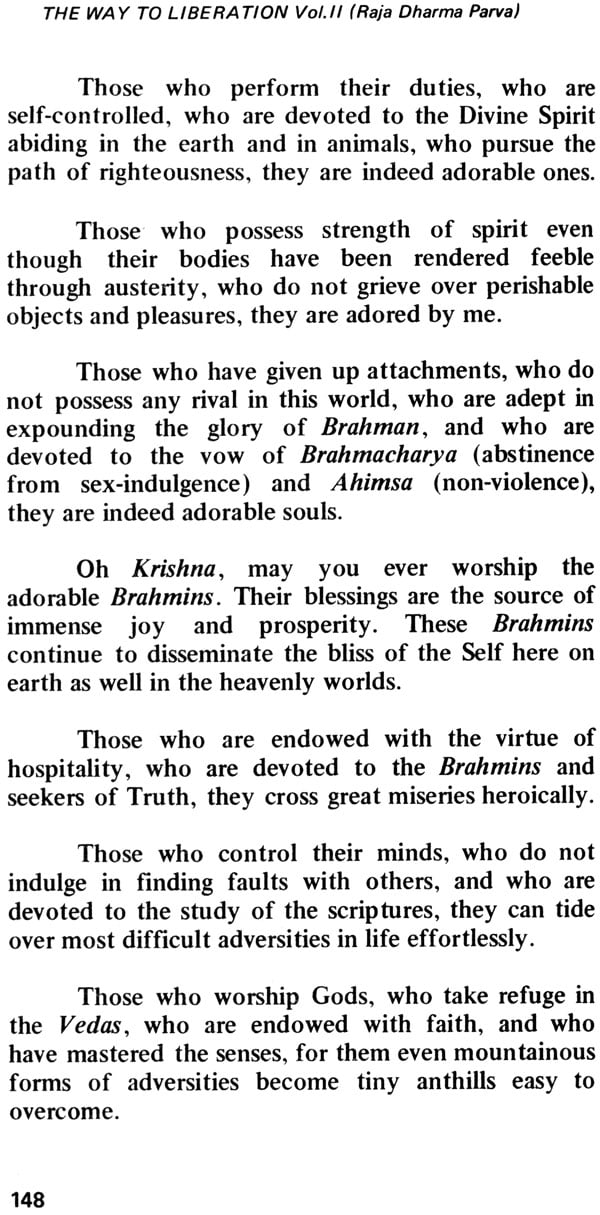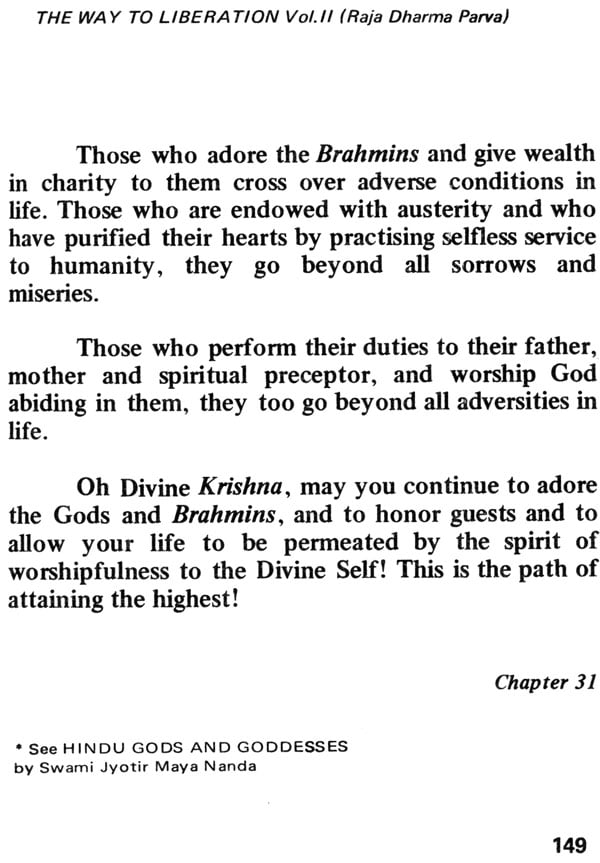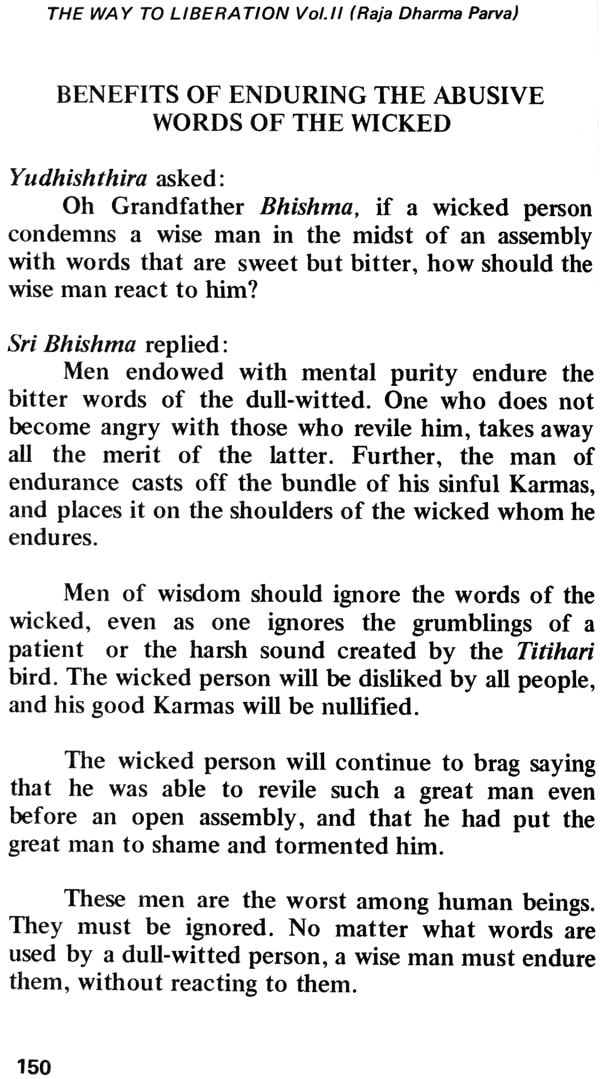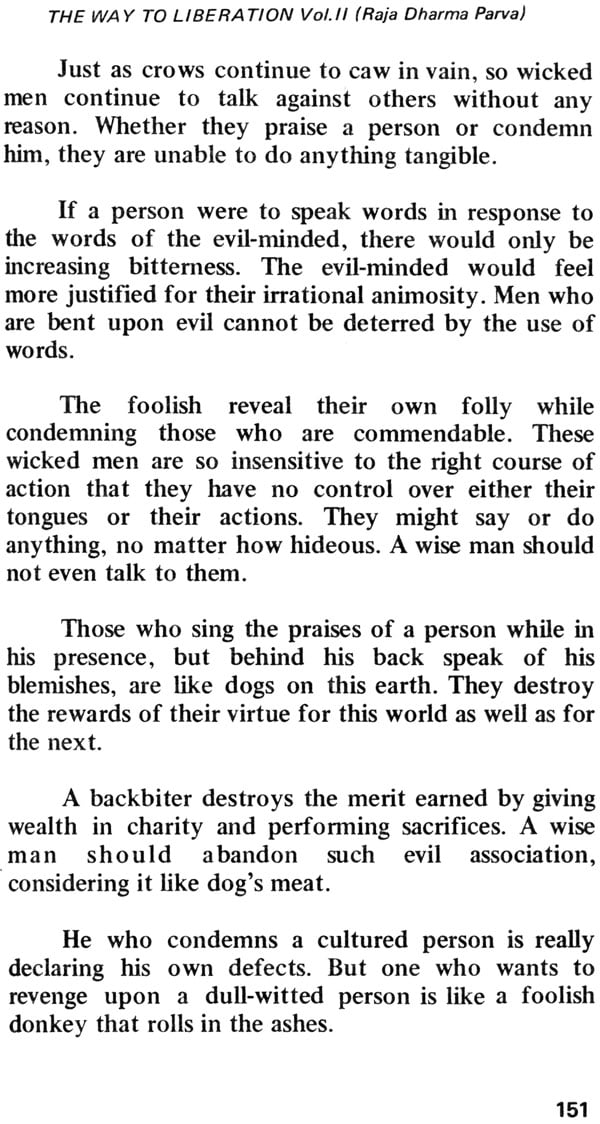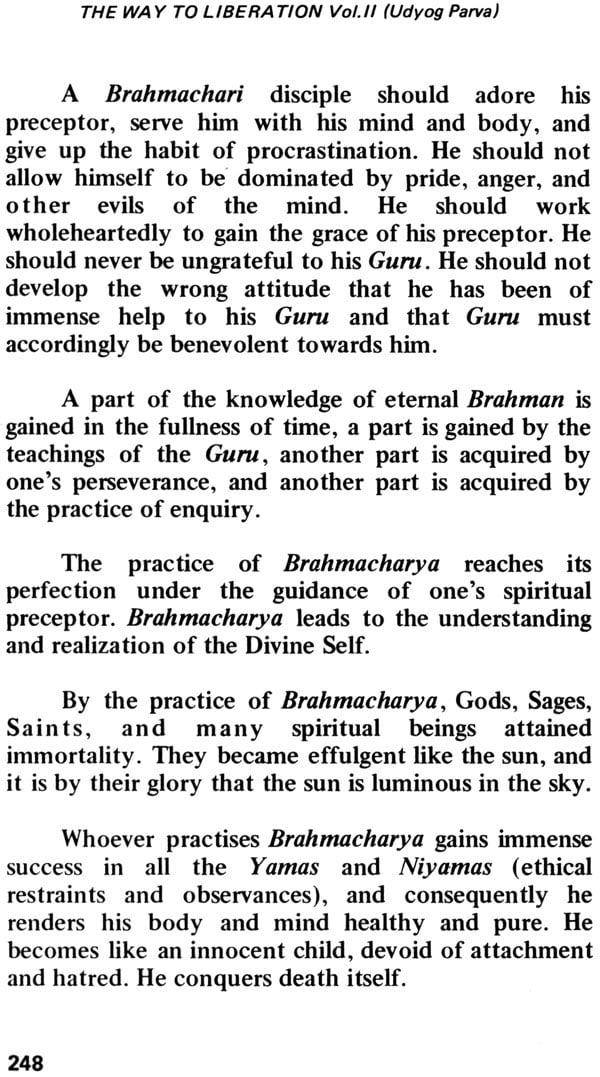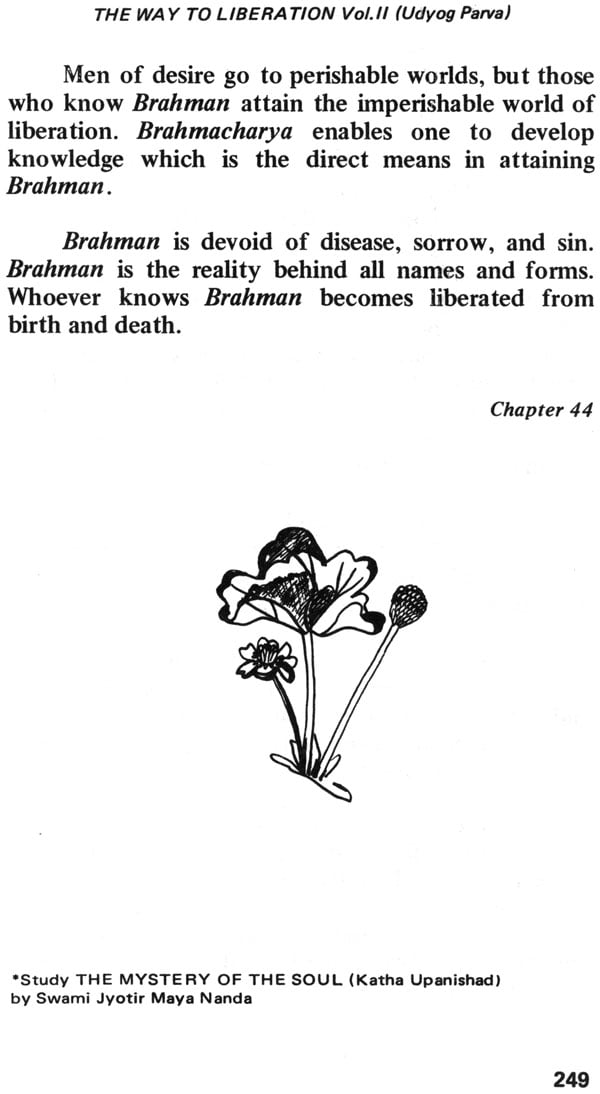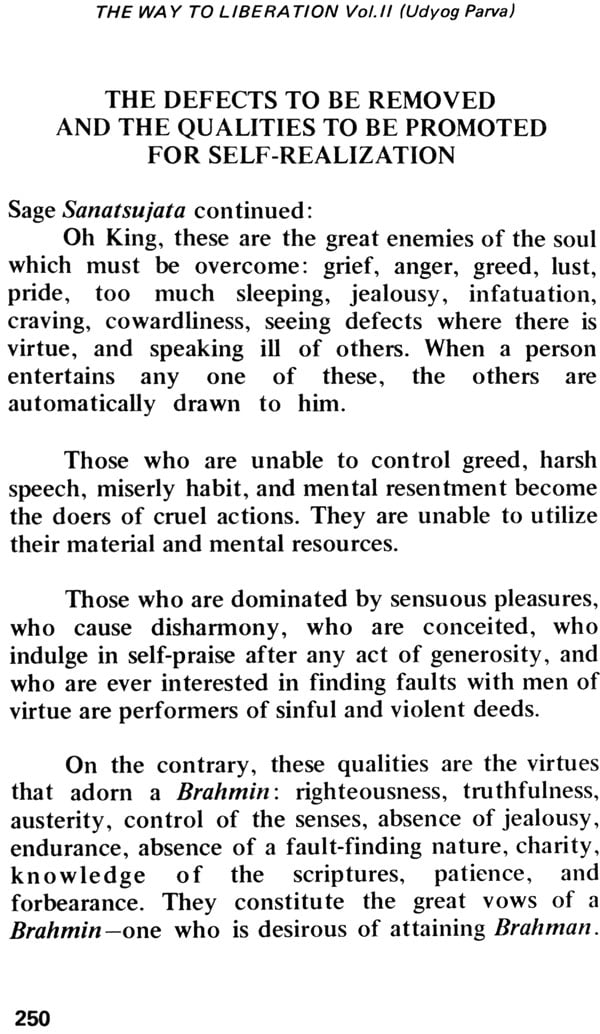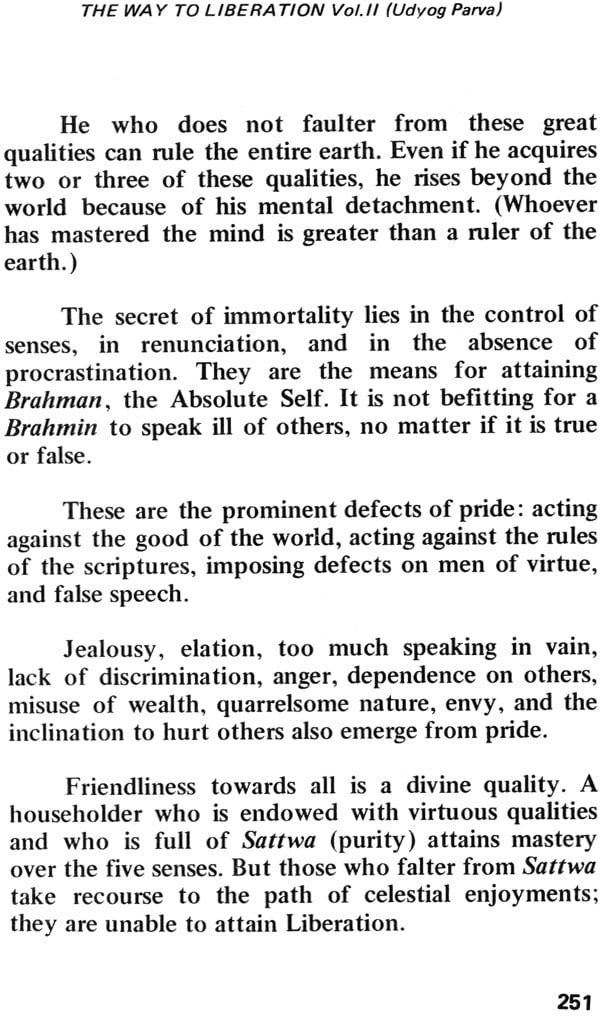
The Way To Liberation (Vol. 2: Mahabharata) (Moksha-Dana-Apat-Raja-Udyog)
Book Specification
| Item Code: | IDL176 |
| Author: | Swami Jyotir Maya Nanda |
| Publisher: | Yoga Research Foundations |
| Language: | English |
| Edition: | 1977 |
| Pages: | 256 (21 B/W Illustrations) |
| Cover: | Paperback |
| Other Details | 8.1" X 5.1" |
| Weight | 250 gm |
Book Description
Publisher’s Note
The Mahabharata is the mother of the world’s most popular scripture - the Gita, which contains the teachings of Lord Krishna. It was composed by Sage Vyasa many centuries before Christ. This grand scripture consisting of eighteen volumes is an extraordinary religious epic.
His Holiness, Sri Swami Jyotir Maya Nanda, the author of over fifty books on Yoga philosophy and related subjects, has written this book steeped in profound knowledge of the Mahabharata for the aspirants of the East as well as the West. The writings of Sri Swami Jyotir Maya Nanda contain a unique blend of simplicity, literary beauty, mystic insight, and a light to guide you on the path to Self-realization.
Swami Jyotir Maya Nanda’s genius lies in writing his profound thoughts and making them alive, almost walking with a dynamic movement. Each one should give this book the fullest and most careful consideration. Consequently, you will feel rushing within a breeze blessed with blazing dispassion, that will dispel fear and doubts which have been restraining you upward movement to the Self-realization.
The Mahabharata is known as the fifth Veda because it deals with all the topics that concern the individual soul on its way to spiritual evolution. It details upon Dharma (ethical value), Artha (material value), Kama (vital value), and Moksha (the infinite spiritual value of life). There is a popular saying, ‘What is not found in the Mahabharata cannot be found in any other scripture. Whatever is there in other scriptures is definitely present in Mahabharata”
Moksha Dharma Parva of the Mahabharata contains the sublime teachings that enable an aspirant to understand the problems of his life in the light of the primary duty of his existence - the attainment of liberation or Self-realization. The teachings were given by Great Bhishma who was a mighty hero among the warriors of ancient India, and even a greater hero in the spiritual field of life. Though lying on the bed of arrows, this majestic personality continued to counsel King Yudhishthira, day after day, on all important subjects that enrich human life and enable the soul to move towards its final attainment - liberation.
The present book contains selected portions of Shanti Parva, the Volume dealing with Peace, retold by Sri Swami Jyotir Maya Nanda in a manner that will enable the reader to gain a deep insight into the beauteous writings of the Mahabharata. The very study of this book is considered highly auspicious. Pious men in India read this section of the Mahabharata to promote harmony and peace in the atmosphere, to remove obstacles and adversities, to acquire health, peace and prosperity, and to move on to the glorious summits of spiritual perfection. Actual chapter numbers are included to help serious students of the Mahabharata.
Stories and parables, illustrations and poetic images, pithy instructions and penetrating insights are blended in this book. Through the study of this book, along with the first volume, one can gain the storehouse of ancient wisdom which is so needed in the troubled times of the present world. May God bless you!
Introduction
The Mahabharata, one of the greatest epic poems ever written, is a voluminious work of eighteen volumes, written to expound the subtle meanings of Dharma or righteousness. The stories and subsidiary stories, parables and epic episodes of this great work are meant to present before the people different problems encountered in life, both on the collective as well as on the individual level, and how men, who are inspired by a sense of Dharma, conduct themselves in order to attain Liberation from the fetters of desires and mortal passions.
The Mahabharata, in a most elegant and attractive manner, presents these deeper meanings and principles of life beginning with King Shantanu, who, in ancient times, had three sons. The eldest, Bhishma, was born of Goddess Ganga, while the other two were born of a mortal. In order to avoid conflict with his stepbrothers, Bhishma had vowed not to accept the throne upon his father’s death, and consequently, Vichitraverrya, the elder of the other two sons, became King. But Vichitraverrya died young, leaving behind two sons, Dhritarashtra and Pandu. Dhritarashtra, being the eldest, was entitled to the throne, but since he was blind, tradition dictated that it pass on to Pandu.
Dhritarashtra had a hundred sons, the eldest known as Duryodhana. He, along with his brothers, were known as the Kauravas, and were full of pride, arrogance, hatred and wickedness. They symbolized all that was evil in the human personality - all that the human soul must conquer in order to attain God-realization. On the other hand, Pandu had five sons, who were known as the Pandavas, and they were the embodiments of virtue. The eldest, Yudhishthira, was the incarnation of Dharma itself. The Pandavas were jewels among men.
Pandu died young, leaving the throne and the Pandavas in the hands of his brother, the blind Dhritarashtra. Although Dhritarashtra loved his sons and the Pandavas deeply, he was always partial to his own sons, and therefore, always assented to all the evil designs of Duryodhana and his brothers.
Bhishma, the grandfather of the Pandavas and Kauravas, loved both parties, but was bound to help the Kauravas due to a vow he had made in the past. However, his heart was always inclined to the virtuous and truthful Pandavas. Many other elders, including Dronacharaya (the Guru and teacher of the Pandavas and Kauravas) also favored the Pandavas, but were also bound to assist Duryodhana and his brothers in their external actions.
There was always anger in the minds of the Kauravas against the Pandavas, which led to great strife between the cousins. One time it became so great that the Kauravas plotted against the lives of the Pandavas, but the latter escaped safely to the forest. There they met Draupadi, the Princess of Panchala, and due to some mysterious Karma, all the five brothers married her.
The conflict still continued, until, through the deceitful malice and treacherous actions of the Kauravas, the Pandavas finally had to accept bandishment into the forest for thirteen years. Along with their wife, they heroically passed their difficult days, exhibiting spiritual strength and patience. During this time they were often visited by Lord Krishna, an incarnation of Lord Vishnu. Seeing the growing conflict between the Pandavas and Kauravas, Krishna finally inspired the Pandavas to enter into a righteous battle against their evil-minded cousins.
Soon the Mahabharata War was inevitable. All the kings of the time allied themselves to one side or the other, and a terrible battle raged in the field of Kurukshetra for eighteen days. (It is at the commencement of this battle that Arjuna received the great teachings of the Bhagavad Gita from Lord Krishna.)
The Mahabharata War caused the destruction of most of the warriors and great men of the time. Bhishma, Dronacharya, Karna and other great warriors and kings were either disabled or killed. But the Pandavas won the war, and Yudhishthira finally became the King of his own rightful land. Thus, a righteous cause was assisted by Lord Krishna, and was brought to fruition by His profound wisdom.
With this story as the general plot, the Mahabharata presents a picture of life in all its richness, in all its profundity and majesty, in all its struggles and pathetic conditions, in all its glories and triumphs, and inspires people to see and to understand a Divine Plan in the apparent conditions of life. It exhorts one not to lose sight of virtue even when thwarted by adverse conditions, but to exhibit moral and spiritual strength with patience in order to persuade God to one’s side. Thus, one wins the battle of the world-process by achieving triumph over the lower self through the unfoldment of the higher Self.
Wherever there is Dharma, there is Lord Krishna, the Supreme Being. And wherever there is Lord Krishna, there is perfect fruition of life’s purpose - victory in the sense of Self-realization.
| Publisher’s Note | 3 |
| Dedication | 5 |
| Introduction | 9 |
| | |
| The Origin of Fever (Jwara) | 13 |
| Essence of the Thousand Names of Shiva | 17 |
| The Art of Being Sorrowless | 22 |
| Narada Gives Instructions Pertaining to the Path of Blessedness | 25 |
| Sage Arishtanemi Instructs King Sagara | 29 |
| The Path of Supreme Blessedness | 34 |
| The Infallibility of the Law of Karma | 37 |
| How to Repay Five Types of Debts | 39 |
| The Glory of Good Association and the Path the Righteousness | 41 |
| The Evils of Attachment | 43 |
| The Glory of Austerity | 45 |
| The Glory of Good Actions | 49 |
| Different Duties and Virtuous Acts | 50 |
| Questions Answered | 53 |
| Hamsa Gita (The Song of a Swan) | 55 |
| The Nature of the Path of Yoga | 59 |
| Samkhya Yoga: Its Practice and Results | 61 |
| The Nature of Kshara and Akshara | 68 |
| Entry into Prakriti | 70 |
| Fall of the Soul through Contact with Prakriti | 73 |
| Yoga and Samkhya | 75 |
| The Experiences of a Fully Blossmed Yogi | 78 |
| The Nature of the Supreme Self | 81 |
| Instructions for a Spiritual Seeker | 83 |
| The Three Gunas and their Characteristics | 85 |
| Discrimination between Purusha and Prakriti | 88 |
| Yoga in Practice | 89 |
| Different types of Death and the Method of Conquering Death | 91 |
| Sage Yajnavalka Tells How He Received Vedic Wisdom from the Sun-god | 94 |
| How to Transcend Birth and Death | 98 |
| Sulabha Holds Spiritual Discussions with King Janaka by Entering his Body | 100 |
| Sage Vyasa’s Instructions to his Son - Shuka | 107 |
| The Fruits of Karma | 115 |
| Sri Shukadeva Goes to King Janaka to Receive Spiritual Instructions | 117 |
| King Janaka Instructs Sri Shukadeva | 121 |
| Sage Vyasa Instructs his Disciples | 125 |
| Sage Narada Instructs Sri Shuka | 132 |
| Sage Narada Instructs Sri Shuka | 137 |
| Sri Shukadeva’s Upward Ascent | 143 |
| | |
| Characteristics of a Person Fit to be Adored | 146 |
| Benefits of Enduring the Abusive Words of the Wicked | 150 |
| Story of Indra and Prahlada | 154 |
| The Story of Expectation (Asha) | 157 |
| | |
| The Unity of Ignorance and Greed | 162 |
| The Glory of Dama (Control of the Senses) | 164 |
| The Nature and Glory of Truth | 167 |
| | |
| Sage Narada Receives Instructions Pertaining to the Glory of Lord Narayana | 171 |
| The Story of King Uparichara | 175 |
| Non-violence in Sacrificial Offerings | 182 |
| Sage Narada Praises Lord Vishnu | 184 |
| Conclusion of Moksha Dharma Parva | 188 |
| | |
| The Story of Gautami and her Son | 189 |
| Self-effort Excels Destiny | 192 |
| The Fruits of Karma | 195 |
| The Glory of Brahmins | 198 |
| Where Does Goddess Lakshmi Abide? | 201 |
| Karmas that Prolong Life and Karmas that Reduce Life | 203 |
| The Glory of Mental Pilgrimage | 207 |
| | |
| Sage Vidura Commences his Teachings to Dhritarashtra | 210 |
| The Characteristics of Highly Cultured Men | 216 |
| Righteous Conduct | 221 |
| Virtuous Qualities | 224 |
| Laws of Righteousness | 229 |
| | |
| Wisdom Imparted by Sage Sanatsujata | 231 |
| The Virtues that Promote Self-realization | 240 |
| Attainment of Brahman through Brahmacharaya | 247 |
| The Defects to be Removed and the Qualities to be Promoted for Self-realization | 250 |
| The Nature of Brahman | 253 |
